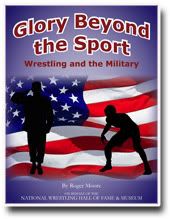At the end of World War II both men returned to Iowa to attend college, Brand at Iowa State University and Leeman at Iowa State Teachers College (now the University of Northern Iowa). Each also resumed a wrestling career that had begun as a schoolboy. Leeman had been an outstanding high school wrestler, winning a national AAU freestyle championship in 1940. Brand’s interscholastic career was far less stellar. He qualified for the Iowa State tournament only once and did not place.
Leeman won an NCAA title in 1946 and Brand won in 1948. Both were members of the American team that traveled to London for the 1948 Olympics. Leeman won a Silver Medal and Glen Brand won the ultimate prize for an amateur wrestler – Olympic Gold. Both men would continue to influence the sport throughout their lives – Leeman as a long-time coach at Lehigh University and Brand as a major supporter of wrestling at the University of Nebraska – Omaha. Because of their accomplishments and contributions to wresting each was inducted as a Distinguished Member of the National Wrestling Hall of Fame – Leeman in 1977 and Brand in 1978.
Sadly, the parallel nature of their lives continued until the very end and both men passed away this past year.
Gerry Leeman and Glen Brand are just a few of the many Americans who have wrestled and served in the military. Glory Beyond the Sport: Wrestling and the Military, examines the centuries-old relationship between the two. It is written by Roger Moore and published by the National Wrestling Hall of Fame.

Last month Mark Palmer wrote a detailed review of the book for InterMat Rewind.
Read Mark's review here.
You can buy the book on The Hall of Fame's website.
Glory Beyond the Sport is just one of several outreach projects from the Hall of Fame. In recent years Lee Roy Smith and his staff have toiled diligently to emphasize the relevance wrestling has had to our history and society. They also published The Wrestling Presidents: From Pins to Patriots and celebrated the contributions of African-Americans to the sport with a traveling exhibit.
I suspect that Dr. Melvin Jones would be proud. In 1972 Myron Roderick had a dream. The former Oklahoma State coach and first executive director of USA Wrestling wanted to establish a wrestling hall of fame. Myron shared his dream with Dr. Jones. Dr. Melvin Jones had been the youngest full professor at Oklahoma State University and a noted agronomist. When a serious eye injury forced him to give up teaching, he became a successful businessman. Working tirelessly (and giving much of his own money) Dr. Jones helped bring Myron Roderick’s dream to fruition. For those efforts, Dr. Melvin Jones was inducted as a Distinguished Member of the NWHOF in 1996. Dr. Jones also passed away last fall.
On this day set aside for remembering, I hope you’ll think of Gerry Leeman, Glen Brand and Dr. Melvin Jones.
Addendum
I finished writing the above Saturday and was just waiting for my usual Monday morning to post. Each Memorial Day and Veterans Day over the two-year lifespan of this blog I have written one honoring veterans. My dad served in Korea, was active in veterans affairs and taught me to respect those that have served. As strongly as I feel about the debt we owe these men and women there has always been a certain amount of detachment – until yesterday.
Mark Rowell was the best man at my wedding. I have known his son Matthew all of his life. My favorite moment in Matt’s life was when he was six or seven years old. I had just helped Mark move a freezer into the basement of their brand new home and Mark, Matt and I were on their back deck. Mark went inside to get a couple of cold ones. Matt climbed to the top rail of the deck, turned to me and said, “They hate it when I do this. They think its dangerous” - and then jumped six or seven feet to the ground.
A year and a half after he graduated from Cedar Rapids Kennedy High School, where he was a catcher on the varsity baseball team, Matt enlisted in the army. Yesterday, I learned that Matt has been seriously wounded in Afghanistan. The army Cougar he was driving hit a roadside bomb. He will survive, but both legs have suffered massive trauma. Today Mark and his wife, Tami, will reunite with Matt at Walter Reed Hospital.
Its so easy to forget that these young people who go off to war are someone’s son, or daughter, or mother, or father, or brother or sister. All across America today there are those who are remembering a lost loved one or who are worrying about the safety of someone serving in harm’s way. We owe them our best wishes.